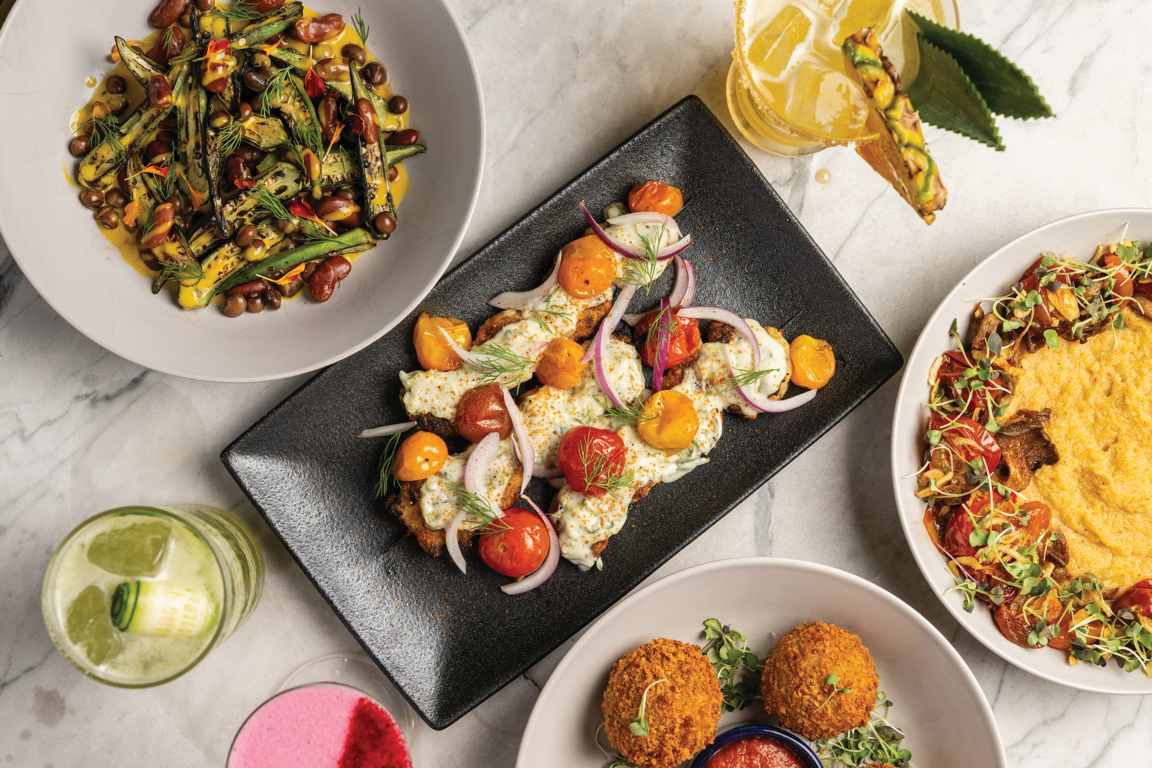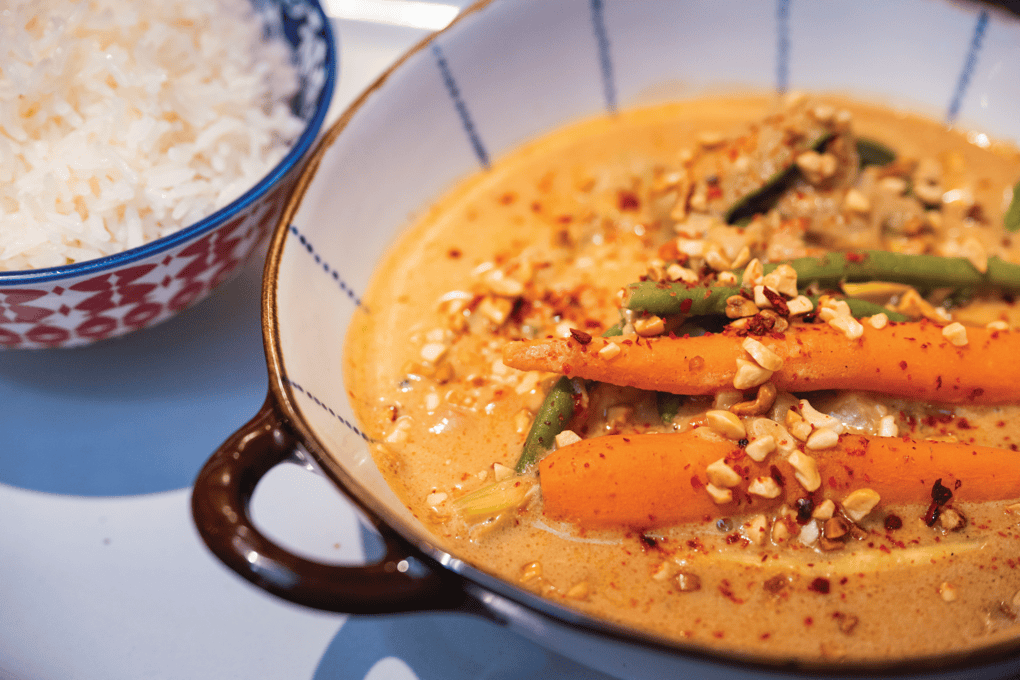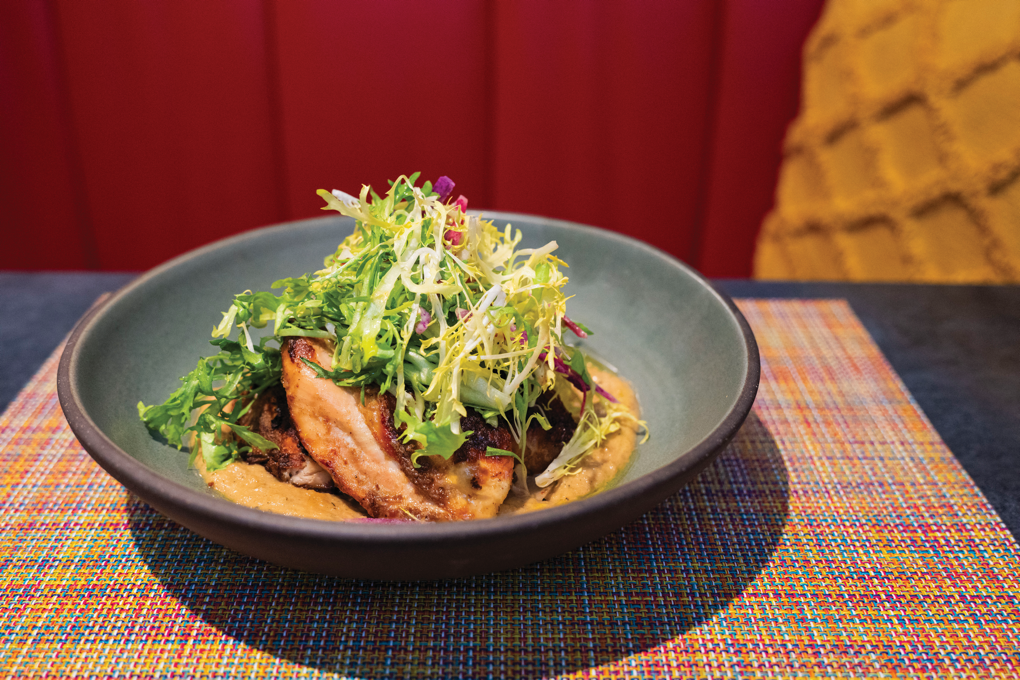
Exploring West African Cuisine
Discovering the rich culinary traditions of this diverse region
Exploring West African Cuisine
Discovering the rich culinary traditions of this diverse region
By Katie Ayoub
February 7, 2024
By Katie Ayoub
February 7, 2024
West African cuisine is characterized by a vibrant street-food culture, aromatic spice blends, spicy condiments and comfort-centric rice dishes, stews and soups. Its cuisine is complex and varied, with each country in the region boasting its own unique dishes and drinks. Nigeria, Ghana and Senegal shine particularly bright as culinary stars, lighting the path and leading the way in introducing West African flavors to the U.S. culinary scene. The growing interest in this cuisine is evident, placing it at the forefront of modern menu ideation and offering a fresh interpretation of the region’s rich food traditions.
The time is right for exploration. West African cuisine rings a lot of bells for today’s diners. Its broad use of multilayered spices, ancient grains, live-fire cooking and slow braises are especially appealing. Many of its signature dishes are plant-based and/or gluten-free, fitting into current lifestyle diets and preferences. “Our cuisine is not complicated. It’s full of flavor, but it’s simple. That’s a big part of its draw with diners,” says Mawa McQueen, executive chef/owner of Mawa’s Kitchen in Aspen, Colo.
McQueen, originally from the Côte d’Ivoire but raised in Paris, France, is one of the culinary ambassadors helping to shape how West African cuisine is showing up on American menus today. Other champions behind the movement include Ghanaian-American “Top Chef” alum Eric Adjepong and Ayo Balogun, chef/owner of Dept of Culture, a Brooklyn, N.Y., concept that draws on his Nigerian upbringing. Shenarri “Greens” Freeman, executive chef of the newly opened Ubuntu, a plant-based West African restaurant in Los Angeles from Overthrow Hospitality, offers a menu inspired by exploration of her African roots. “I’m excited about delving further into West African cuisine; a little bit of Nigeria, Ghana and Senegal is just the beginning of it all,” says Freeman.
Ambassadors are moving the needle for West African cuisine in the fast-casual space, too, showcasing how star flavors shine in approachable formats. Hema Agwu and Folusho Adeyemo, both with Nigerian roots, are co-owners of Brooklyn Suya, a fast casual that menus customizable bowls inspired by West African flavors and ingredients. Pop culture plays a supporting role in this movement. In the popular TV show “Ted Lasso,” one of the main characters is Nigerian and opens a West African restaurant in London. The plotline serves as an emotional touchpoint and flavor postcard, deepening consumer interest in the dishes that are featured on the show with great affection.
“As familiarity with West African cuisine increases in this country, today’s consumer gets more invested in the flavors,” says Claire Conaghan, trendologist and associate director of publications, Datassential. “Once they discover it, there’s a savory, craveable flavor that appeals to diners, dialing up their enthusiasm to see more of it on menus.”

 Photo Credit: Mawa’s KitchenMawa’s Kitchen, located in Aspen, Colo., runs the Vegetable Maffe with West African peanut curry, seasonal vegetables and jasmine rice (top) and Berbere-Spiced Chicken Yassa with braised Vidalia onion, yassa sauce and a frisée herb salad (bottom).
Photo Credit: Mawa’s KitchenMawa’s Kitchen, located in Aspen, Colo., runs the Vegetable Maffe with West African peanut curry, seasonal vegetables and jasmine rice (top) and Berbere-Spiced Chicken Yassa with braised Vidalia onion, yassa sauce and a frisée herb salad (bottom).
Third-Culture Cooking
The influence of the African diaspora is evident in the culinary realm, weaving a significant narrative within third-culture cooking, a phenomenon that celebrates the creative evolution of dishes originating from diaspora communities. It’s one of the primary drivers giving rise to West African cuisine in America. Third-culture cooking is a relatively new moniker, a modern spin-off of the global mash-up, lending a more personal narrative to eclectic American food culture.
McQueen’s menu at Mawa’s Kitchen is a great showcase of third-culture cooking. “I grew up in low-income housing in France, and my neighbors were Moroccan, Algerian, Tunisian and West African. My family was from Côte d’Ivoire, so while we were cooking African food, neighbors might be cooking Mediterranean or Moroccan dishes. I grew up with all these flavors and influences. When you live in the ghetto, food is your currency. We exchange food and culture. That’s had a big impact on my cooking and my mission at Mawa’s,” says McQueen. She speaks to the slow burn of a cuisine that has been on the periphery for decades, now catching fire across the U.S. “When I opened the restaurant in 2012, there’s no way I could have put fonio on the menu. I’m in Aspen, the whitest town in America, but I gained a following and built trust. Then, after George Floyd, I took a deep look at myself to find out what I’m passionate about and define my cooking more clearly, celebrating my identity and sharing that cuisine—through my lens—with my guests.”
She started with fonio, an ancient grain grown on the African continent that’s both nutrient-dense and gluten-free. “I put it in an arugula salad, because people in Aspen love their salad,” McQueen says. She concedes that it was initially a hard sell, but it soon caught on, eventually becoming a popular dish. Today, the supergrain is also featured on the breakfast menu. Her Fonio Pancakes are made with a fonio batter and topped with a fruit compote. Vegetable Maafe makes a showing on lunch and dinner menus, described as a West African peanut curry with seasonal vegetables and jasmine rice. “Maafe reflects the simplicity and goodness inherent in much of our cuisine,” she says. Her version features ground organic peanuts, fresh ginger, vegetable broth, garlic and berbere spice.
The region’s affinity for plant-based cookery comes into sharp focus at Ubuntu with dishes like Lion’s Mane Pie, featuring habanero and tamarind applesauce, and Grilled Cabbage, made with berbere butter. Freeman’s menu is another example of third-culture cooking, showcasing the chef’s exploration of her roots along with her passion for vegan flavor development. “West African cuisine is very plant-forward, which makes running a menu that’s 100 percent vegan a little bit easier,” says Freeman, who is also the executive chef of Cadence, a vegan soul food restaurant in New York.
The Big Three
While there’s a wealth of flavor inspiration springing from the West African pantry, three flavor profiles offer some of the broadest potential for translation: suya, yassa and jollof rice.
Nigerian suya is both a spice blend and roadside skewered-and-spiced meat, giving menu developers here significant opportunity for interpretation. Featuring a blend of peanuts, spices, chiles, ginger and salt, suya’s making big moves on menus today. “The suya spice blend is absolutely something everyone can love,” says Marcus Samuelsson, an early pioneer in bringing West African—along with Ethiopian—cuisines to the fore in American foodservice. At Red Rooster in New York, the celebrated chef has featured a Beef Suya Bowl, with coconut rice, red onion, avocado, plantains, boiled egg and cilantro. McQueen also serves a beef suya dish, translating it on her menu as Beef Tenderloin with African spice, accompanied by yuca fries and chermoula. Her version of suya leads with paprika, peanuts, Scotch bonnet peppers and a little soy sauce. At Brooklyn Suya, the spice is the fast casual’s centerpiece, especially in customizable Suya Bowls, where it is added to chicken, shrimp, salmon, tofu or eggplant. Tatiana in New York spins it into an inventive Short Rib Pastrami Suya, featuring boneless Wagyu short rib, caraway coco bread and melted red cabbage.
Yassa, a Senegalese stew, offers big opportunity, too, leading with a comfort-centric combination of chicken, caramelized onion, ginger and lime. At Mawa’s Kitchen, the Berbere-Spiced Chicken Yassa boasts braised Vidalia onion, yassa sauce and a frisée herb salad. Freeman menus a plant-based version at Ubuntu, subbing the traditional chicken with jackfruit and adding coconut “milk” for creaminess.
 Photo Credit: Monhand Mathurin
Photo Credit: Monhand Mathurin Ubuntu demonstrates the innovation possibilities in West African beverage development with drinks like its booze-free Sobolo Mule, made with hibiscus, grains of paradise, pomegranate, coconut water, ginger and seltzer.
Jollof rice was one of the first West African dishes to find its way onto mainstream American menus thanks to an approachable profile that’s similar to jambalaya and red rice. Traditionally made with long-grain rice, it features tomatoes, onion, herbs and spices. Iterations abound, from Ubuntu’s Jollof Arancini with curry, tomato and miso to the jollof basmati rice that serves as the foundation for a few bowl builds at fast casual Fieldtrip, with three locations in New York.
Faithful replication of West African dishes is not necessary. Instead, innovation and interpretation are the order of the day. But an approach rooted in respect and authenticity provides a winning roadmap. “Keep the integrity of the food intact,” says McQueen. “Keep it uncomplicated. But, of course, innovation fuels our industry. Yassa loaded fries would be delicious—as long as you respect the yassa and where it comes from.”
West African cuisine is characterized by a vibrant street-food culture, aromatic spice blends, spicy condiments and comfort-centric rice dishes, stews and soups. Its cuisine is complex and varied, with each country in the region boasting its own unique dishes and drinks. Nigeria, Ghana and Senegal shine particularly bright as culinary stars, lighting the path and leading the way in introducing West African flavors to the U.S. culinary scene. The growing interest in this cuisine is evident, placing it at the forefront of modern menu ideation and offering a fresh interpretation of the region’s rich food traditions.
The time is right for exploration. West African cuisine rings a lot of bells for today’s diners. Its broad use of multilayered spices, ancient grains, live-fire cooking and slow braises are especially appealing. Many of its signature dishes are plant-based and/or gluten-free, fitting into current lifestyle diets and preferences. “Our cuisine is not complicated. It’s full of flavor, but it’s simple. That’s a big part of its draw with diners,” says Mawa McQueen, executive chef/owner of Mawa’s Kitchen in Aspen, Colo.
McQueen, originally from the Côte d’Ivoire but raised in Paris, France, is one of the culinary ambassadors helping to shape how West African cuisine is showing up on American menus today. Other champions behind the movement include Ghanaian-American “Top Chef” alum Eric Adjepong and Ayo Balogun, chef/owner of Dept of Culture, a Brooklyn, N.Y., concept that draws on his Nigerian upbringing. Shenarri “Greens” Freeman, executive chef of the newly opened Ubuntu, a plant-based West African restaurant in Los Angeles from Overthrow Hospitality, offers a menu inspired by exploration of her African roots. “I’m excited about delving further into West African cuisine; a little bit of Nigeria, Ghana and Senegal is just the beginning of it all,” says Freeman.
Ambassadors are moving the needle for West African cuisine in the fast-casual space, too, showcasing how star flavors shine in approachable formats. Hema Agwu and Folusho Adeyemo, both with Nigerian roots, are co-owners of Brooklyn Suya, a fast casual that menus customizable bowls inspired by West African flavors and ingredients. Pop culture plays a supporting role in this movement. In the popular TV show “Ted Lasso,” one of the main characters is Nigerian and opens a West African restaurant in London. The plotline serves as an emotional touchpoint and flavor postcard, deepening consumer interest in the dishes that are featured on the show with great affection.
“As familiarity with West African cuisine increases in this country, today’s consumer gets more invested in the flavors,” says Claire Conaghan, trendologist and associate director of publications, Datassential. “Once they discover it, there’s a savory, craveable flavor that appeals to diners, dialing up their enthusiasm to see more of it on menus.”

 Photo Credit: Mawa’s KitchenMawa’s Kitchen, located in Aspen, Colo., runs the Vegetable Maffe with West African peanut curry, seasonal vegetables and jasmine rice (top) and Berbere-Spiced Chicken Yassa with braised Vidalia onion, yassa sauce and a frisée herb salad (bottom).
Photo Credit: Mawa’s KitchenMawa’s Kitchen, located in Aspen, Colo., runs the Vegetable Maffe with West African peanut curry, seasonal vegetables and jasmine rice (top) and Berbere-Spiced Chicken Yassa with braised Vidalia onion, yassa sauce and a frisée herb salad (bottom).
Third-Culture Cooking
The influence of the African diaspora is evident in the culinary realm, weaving a significant narrative within third-culture cooking, a phenomenon that celebrates the creative evolution of dishes originating from diaspora communities. It’s one of the primary drivers giving rise to West African cuisine in America. Third-culture cooking is a relatively new moniker, a modern spin-off of the global mash-up, lending a more personal narrative to eclectic American food culture.
McQueen’s menu at Mawa’s Kitchen is a great showcase of third-culture cooking. “I grew up in low-income housing in France, and my neighbors were Moroccan, Algerian, Tunisian and West African. My family was from Côte d’Ivoire, so while we were cooking African food, neighbors might be cooking Mediterranean or Moroccan dishes. I grew up with all these flavors and influences. When you live in the ghetto, food is your currency. We exchange food and culture. That’s had a big impact on my cooking and my mission at Mawa’s,” says McQueen. She speaks to the slow burn of a cuisine that has been on the periphery for decades, now catching fire across the U.S. “When I opened the restaurant in 2012, there’s no way I could have put fonio on the menu. I’m in Aspen, the whitest town in America, but I gained a following and built trust. Then, after George Floyd, I took a deep look at myself to find out what I’m passionate about and define my cooking more clearly, celebrating my identity and sharing that cuisine—through my lens—with my guests.”
She started with fonio, an ancient grain grown on the African continent that’s both nutrient-dense and gluten-free. “I put it in an arugula salad, because people in Aspen love their salad,” McQueen says. She concedes that it was initially a hard sell, but it soon caught on, eventually becoming a popular dish. Today, the supergrain is also featured on the breakfast menu. Her Fonio Pancakes are made with a fonio batter and topped with a fruit compote. Vegetable Maafe makes a showing on lunch and dinner menus, described as a West African peanut curry with seasonal vegetables and jasmine rice. “Maafe reflects the simplicity and goodness inherent in much of our cuisine,” she says. Her version features ground organic peanuts, fresh ginger, vegetable broth, garlic and berbere spice.
The region’s affinity for plant-based cookery comes into sharp focus at Ubuntu with dishes like Lion’s Mane Pie, featuring habanero and tamarind applesauce, and Grilled Cabbage, made with berbere butter. Freeman’s menu is another example of third-culture cooking, showcasing the chef’s exploration of her roots along with her passion for vegan flavor development. “West African cuisine is very plant-forward, which makes running a menu that’s 100 percent vegan a little bit easier,” says Freeman, who is also the executive chef of Cadence, a vegan soul food restaurant in New York.
The Big Three
While there’s a wealth of flavor inspiration springing from the West African pantry, three flavor profiles offer some of the broadest potential for translation: suya, yassa and jollof rice.
Nigerian suya is both a spice blend and roadside skewered-and-spiced meat, giving menu developers here significant opportunity for interpretation. Featuring a blend of peanuts, spices, chiles, ginger and salt, suya’s making big moves on menus today. “The suya spice blend is absolutely something everyone can love,” says Marcus Samuelsson, an early pioneer in bringing West African—along with Ethiopian—cuisines to the fore in American foodservice. At Red Rooster in New York, the celebrated chef has featured a Beef Suya Bowl, with coconut rice, red onion, avocado, plantains, boiled egg and cilantro. McQueen also serves a beef suya dish, translating it on her menu as Beef Tenderloin with African spice, accompanied by yuca fries and chermoula. Her version of suya leads with paprika, peanuts, Scotch bonnet peppers and a little soy sauce. At Brooklyn Suya, the spice is the fast casual’s centerpiece, especially in customizable Suya Bowls, where it is added to chicken, shrimp, salmon, tofu or eggplant. Tatiana in New York spins it into an inventive Short Rib Pastrami Suya, featuring boneless Wagyu short rib, caraway coco bread and melted red cabbage.
Yassa, a Senegalese stew, offers big opportunity, too, leading with a comfort-centric combination of chicken, caramelized onion, ginger and lime. At Mawa’s Kitchen, the Berbere-Spiced Chicken Yassa boasts braised Vidalia onion, yassa sauce and a frisée herb salad. Freeman menus a plant-based version at Ubuntu, subbing the traditional chicken with jackfruit and adding coconut “milk” for creaminess.
 Photo Credit: Monhand Mathurin
Photo Credit: Monhand Mathurin Ubuntu demonstrates the innovation possibilities in West African beverage development with drinks like its booze-free Sobolo Mule, made with hibiscus, grains of paradise, pomegranate, coconut water, ginger and seltzer.
Jollof rice was one of the first West African dishes to find its way onto mainstream American menus thanks to an approachable profile that’s similar to jambalaya and red rice. Traditionally made with long-grain rice, it features tomatoes, onion, herbs and spices. Iterations abound, from Ubuntu’s Jollof Arancini with curry, tomato and miso to the jollof basmati rice that serves as the foundation for a few bowl builds at fast casual Fieldtrip, with three locations in New York.
Faithful replication of West African dishes is not necessary. Instead, innovation and interpretation are the order of the day. But an approach rooted in respect and authenticity provides a winning roadmap. “Keep the integrity of the food intact,” says McQueen. “Keep it uncomplicated. But, of course, innovation fuels our industry. Yassa loaded fries would be delicious—as long as you respect the yassa and where it comes from.”
About the Author
![]() Katie Ayoub serves as managing editor of Flavor & The Menu and content strategist for the Flavor Experience, an annual conference geared toward chain operators. She is president of Katie Ayoub & Associates, serving up menu trends expertise, content creation and food & beverage consultancy. Based in Chicago, Katie has been working in foodservice publishing for more than 20 years and part of the Flavor team since 2006. [email protected]
Katie Ayoub serves as managing editor of Flavor & The Menu and content strategist for the Flavor Experience, an annual conference geared toward chain operators. She is president of Katie Ayoub & Associates, serving up menu trends expertise, content creation and food & beverage consultancy. Based in Chicago, Katie has been working in foodservice publishing for more than 20 years and part of the Flavor team since 2006. [email protected]







